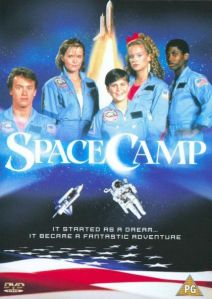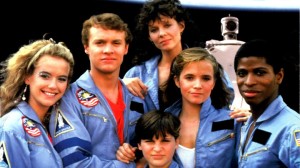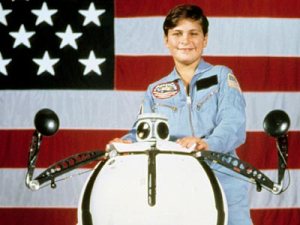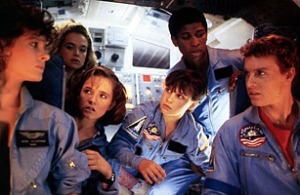Is there a movie that is more pure, uncut 80s in its essence than Spacecamp? I mean, it’s got a team of Plucky Young Misfits, there’s a cute robot. Plus, it all rests on a pretty big gimmick.
So, here’s the gimmick of Spacecamp: teenagers accidentally launched into space. Hijinks ensue. But not typical teenager hijinks. It’s not like there’s a kegger in the ISS or something like that. The hijinks of “Oh, damnit, we’re in space were a thousand different things can go wrong and five children are going to die”, which are less, you know, wacky and fun. In fact, this movie pretty much bombed for that very reason, because in between production and release, there was the Challenger explosion. So marketing a Wacky NASA Accident movie was… problematic.
We start with a bunch of kids at Spacecamp, which is a real camp teenagers can go to, where they get trained “just like astronauts—and notice I didn’t say real astronauts, because at SpaceCamp, you are REAL astronauts”. Word for word from the movie, people: condescension to children who are paying you for the privilege.
First we establish Kate Capshaw as a NASA astronaut hopeful who gets stuck with being a counselor, since her significant other/everyone’s dad Tom Skerritt sticks her with it while he does Real NASA stuff, like a man. This strikes me as a bizarre set-up and even more of an HR nightmare. I mean, astronauts (and potential astronauts) would have a completely different career path over camp counselors. I seriously doubt there’s people at NASA who don’t know before Day One of the camp whether they’re training for a mission or going up in space. The camp people would just do that, and the astronaut people would show up and wave one day and get back to their regular jobs. Kate Capshaw is, therefore, rightly annoyed, but does her job like a good soldier. Her main team of kids includes the Empty Charmer (Tate Donovan), the Driven Perfectionist (Lea Thompson) the Ditzy Genius (Kelly Preston), the Token Minority (Larry B. Scott) and the Kid (Joaquim Phoenix, back when he was still Leaf Phoenix).

Now, I just want to call bullshit on the Kid being in the mix here. There’s some throwaway lines that he’s been at the kiddie camp version of SpaceCamp for three years, and he feels he’s ready for doing the teen one, even though he’s eleven and everyone else is seventeen. And he’s gone there enough that Kate knows him on sight, which tells me that, no, the camp is her real job and she should accept that. Anyhow, after a brief argument Kate Capshaw caves and lets him stay. And… no. Just no. Camps have age ranges for a reason, largely because on a socialization in age ranges and, you know, vastly different liabilities between handling 11-year-olds over 17-year-olds (or handling them together.) I’ve never seen a camp– at least a professional one– that would not only bend the rules that strongly, but allow a counselor the freedom to do so entirely on her whim without checking with anyone. But, hey, this is a place that’s all, “Today you’re running the camp, tomorrow you might be on a shuttle mission”, so who knows.
Plus there’s the robot, Jinx. Jinx annoys the hell out of me, in that he moves this movie entirely into science-fiction. I mean, yeah, there’s a hell of a lot of implausibility otherwise, but Jinx is a robot with complete sentience and free will. For that matter, the main NASA computer seems to be the same. I’m getting ahead of myself, but… the kids end up in space because Jinx engineers it. Which he does by talking to the NASA computer, and the two of them come up with a plan and implement it. Seriously, there are scenes where Jinx links up with the computer, and they’re all, “So, if I can get the kid on the shuttle for an engine test, how can I make the engine test into a launch?” “Well, if this happened, then NASA would be forced to launch the shuttle.” “LET’S DO THIS.” All done by our computer/robot overlords.
But I’m ahead of myself here: Team Misfit essentially are screw-ups, at least as a team. Mostly because Tate Donovan is named Mission Commander, despite the fact that he only has one fuck to give, and he wants to give it to Lea Thompson. Lea is all “I MUST BE THE BEST AND YOU LOSERS ARE SLOWING ME DOWN”. Kelly Preston really just doesn’t… anything. Seriously, she doesn’t even get some token “problem” to overcome. And Larry is just terrible, and works himself into knots over being terrible. The Kid is eleven and has no business being there. Except that’s why we have a plot.
See, Tate at least has the decency to bond with the Kid, but when Tate gets busted for slipping off campus with Lea, he blames the Kid, even though it was Jinx’s fault. Of course, Jinx is in the dorms because the Kid snuck him in for… some reason? Anyway, sad over Tate yelling at him, the Kid wishes he was in space, so Jinx decides to make it happen.
I CANNOT STRESS THIS ENOUGH: THE ROBOT DECIDES TO MAKE IT HAPPEN. THE ROBOT, IN A MOVIE OTHERWISE PRETENDING TO BE IN THE REALM OF REALISTIC, IN A MOVIE SET AND MADE IN 1986, DECIDES TO MAKE IT HAPPEN.

I can only imagine in some script-doctoring meeting, where they couldn’t figure out how to make the launch happen without it being a real, legitimate ACCIDENT—which totally wouldn’t have played after Challenger—so they were all, “Fuck it, a robot does it.”
Meanwhile, there is also an undercurrent of gender politics as Kate Capshaw is totally grinding Lea Thompson down, while letting Tate ride on nothing but a stupid ass grin, which more or less matches her view of what’s going on at NASA. She doesn’t even get a mission, while Tom Skerritt’s walked on the moon.
So, anyway, there’s going to be an engine test of the shuttle Atlantis, and they’re going to give one SpaceCamp team the honor of sitting in the shuttle while it happens. Jinx rigs things so the our heroes end up as the selected team, and then while they’re in there, he triggers the THERMAL CURTAIN FAILURE that forces a launch.
THE ROBOT. CAUSES A THERMAL CURTAIN FAILURE.
So Team Misfit is in space, and NASA is freaking out, and for good reason beyond “We just put five kids in space.” Because this was just an engine test, so Atlantis wasn’t space-ready, which means there’s not enough oxygen, and the radio isn’t hooked up. All of these contrivances seem VERY convenient, in that they make the plot happen. Now, NASA can do telemetry stuff to the ship, so they can tell what is going on, but they can’t talk directly to each other. This is stupid, but in slight fairness, they actually make this a plot point rather than a plot hole, in that Kelly Preston figures out if she flicks a switch in Morse code, someone at NASA should be seeing the light flash and figure it out. Unfortunately, she apparently picks the one thing tied to the one console at NASA no one sits at, because no one notices it until nearly the end of the movie, when FUCKING JINX spots it and decodes it before security throws him out.
This thing with the robot really gets to me.
 Anyhow, both in the ship and at NASA, they realize the same problem: the ship only has twelve hours of air, and because of “landing windows” they can’t bring the ship back in for fourteen hours. All of this sounds like movie-logic bullshit. I mean, yeah, I’m sure the shuttle can’t just zip into the atmosphere just anywhere in order to land at Edwards Air Force, but the “twelve hours between windows” sounds like arbitrary movie rules to create a plot problem. Not to mention “twelve hours of air” is also crazy arbitrary. I mean… I get they didn’t fully stock it. That’s fine. But there’s a little air-counter display showing the time-count, which means it’s automatically doing the math for how much oxygen one adult woman, four teenagers and one eleven year old are using. Of course, when they get a new oxygen canister, it’s also a twelve-hour supply. Which makes me think the filmmakers think oxygen has a static volume-to-usage-time relationship, regardless of how many people are using it.
Anyhow, both in the ship and at NASA, they realize the same problem: the ship only has twelve hours of air, and because of “landing windows” they can’t bring the ship back in for fourteen hours. All of this sounds like movie-logic bullshit. I mean, yeah, I’m sure the shuttle can’t just zip into the atmosphere just anywhere in order to land at Edwards Air Force, but the “twelve hours between windows” sounds like arbitrary movie rules to create a plot problem. Not to mention “twelve hours of air” is also crazy arbitrary. I mean… I get they didn’t fully stock it. That’s fine. But there’s a little air-counter display showing the time-count, which means it’s automatically doing the math for how much oxygen one adult woman, four teenagers and one eleven year old are using. Of course, when they get a new oxygen canister, it’s also a twelve-hour supply. Which makes me think the filmmakers think oxygen has a static volume-to-usage-time relationship, regardless of how many people are using it.
My point is, all the time-based numbers feel like they were written without any thought. Especially considering they are, apparently, up in space about 24 hours by the end of the movie, and they never eat or get thirsty, and only the kid ever has to pee the entire time they’re up there.
Anyhow, both NASA and the crew come up with a solution separately (since they can’t talk to each other: the space-station in progress, Daedalus, has oxygen containers, so they adjust orbit to join up with the station. Problem-solving victory.
Kate Capshaw takes it upon herself to make the spacewalk to get the oxygen, since she’s the adult in the room. So she suits up and goes out there, but some genius designed the grid that holds the containers so an adult in a space-suit cannot get to them. So they send the kid out with Kate (using Kelly Preston’s very 80s belts to tighten the spacesuit up), and he gets the air containers, and then they almost have a crisis when he nearly flies out into open space. There’s a jokey moment of, “Wait until your parents get the bill from NASA for you breaking Daedalus.” Bah. Wait until NASA gets the countersuit for LAUNCHING THEIR CHILD INTO SPACE.
So the oxygen gets hooked up, and NASA is all, “Yeah, let’s take them home.” But while they’re automatically setting that up, Kate Capshaw screws up attaching the second oxygen container, and gets smashed with a flying canister and almost flies off into space. The Kid is trying to reel her in (she’s attached but unconscious) before the doors close, but that isn’t going to happen. So, in the ship, Lea Thompson is FREAKING OUT since she’s supposed to be in charge and can’t figure out what to do. So Tate Donovan steps up, and he overrides NASA so they can save Kate. This leads Lea Thompson to realize she should never ever be in charge of things, and she should just be a pilot. There might be an idea in here about “book smarts don’t necessarily translate into real world decision-making”, but it comes off more as “girls can’t be in charge!” and it’s just kind of gross.
NASA is all, “What the fuck just happened?” and doesn’t know what to do, since it’s another twelve hours for another window, or something, and again: not enough air. This window thing makes no fucking sense to me here, frankly. The movie would have worked just as well had they made these things two hours or something.
The gang on the ship figure out they can land in White Sands as an emergency window—something that NO ONE in the brain trust at NASA can think of, to which again: BULLSHIT. I can’t believe that conversation number one wasn’t, “Where else can we land these kids?” and that there weren’t fifteen guys in the control room who could rattle off all the emergency window options off the top of their head.
But no, it takes Jinx coming in and seeing the blinking light and translating the Morse code message for everything to work out. All problems solved, all that’s left is for Lea Thompson to overcome her last crisis-of-conscience so she can land the ship, which involves the video-game like aspect of keeping the ship at a 30° angle while they descend. Which she does, and the ship lands, and credits roll. IMMEDIATELY, right over the stock footage of the landing. Because denouement is for suckers.
This movie was apparently plagued with production problems, where a two-month shoot ended up taking six months. Somehow after day ONE of shooting, they were already six weeks behind. I’m not sure how that works, but I think it takes highly advanced levels of screwing up to pull it off. It says something when the disaster told in the movie is less severe than the disaster of the movie itself. Despite that, and despite Jinx, there is something engaging about this movie. At least, there was for me at the time, but possibly because I was the same age as the Kid. That might be why I watched it so many times.

